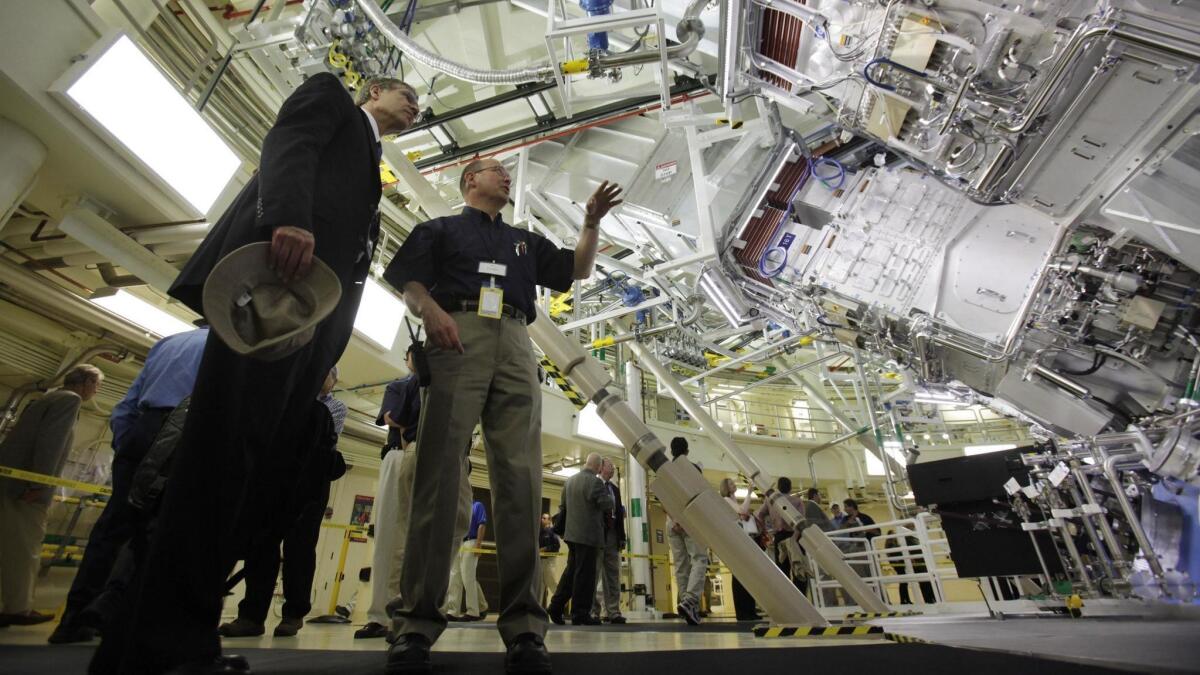Op-Ed: California is complicit in the buildup of nuclear weapons

- Share via
A new nuclear arms race is underway, with California at the center, though it’s not clear its citizens realize it.
Under President Obama, plans were put in place for the U.S. to spend $1.7 trillion over the next 20 years to modernize the nation’s nuclear weapons. President Trump quickly decided that wasn’t enough; he needed new, more “usable” weapons of mass destruction. Last week, Russian President Vladimir Putin announced that his generals were ready to deploy new hypersonic missiles in the “coming months,” and days later Trump announced his intention to tear up the 1987 Intermediate-Range Nuclear Forces Treaty, or INF. The INF ended the first Cold War in 1987; its demise signals the beginning of another.
In California, the new nuclear arms race is bringing in a flood of cash to laboratories run by the University of California, where scientists, engineers and technicians have had a hand in designing every single nuclear weapon the U.S. has ever built. And yet the state Legislature and the Los Angeles City Council have resolved that America should support the U.N.’s 2017 Treaty on the Prohibition of Nuclear Weapons. California is complicit in the arms race, and if nuclear weapons were ever launched, it would be one of the prime attack targets. Its citizens need to speak up to safeguard their future and end the state’s participation in the weapons industry.
The relationship of UC and nuclear weapons goes back to the 1940s, when the university managed the Manhattan Project laboratory at Los Alamos, N.M. That lab developed the first nuclear warhead and the atomic bombs that leveled most of Hiroshima and Nagasaki at the end of World War II. In 1952, UC Berkeley and the Department of Energy set up another weapons research facility, in the Bay Area: Lawrence Livermore National Laboratory. Every warhead ever created and deployed by the U.S. and its allies has been designed by a UC-managed or co-managed lab.
The new nuclear arms race is bringing in a flood of cash to laboratories run by the University of California.
The UC regents have tried to separate the school from the weapons business to some degree. Lawrence Livermore and Los Alamos are now co-managed with Bechtel and the University of Texas. But UC’s direct ties to the labs remain strong. In 2013, when the regents visited Lawrence Livermore, then-lab director Parney Albright said, “UC is the main supplier of talent to the lab. UC faculty have partnered on more [Lawrence Livermore National Laboratory] papers than any other institution.” A third of all postdoctoral researchers at the lab, he said, came from one or another of UC’s 10 campuses.
Although Lawrence Livermore and Los Alamos do not exclusively work on nuclear weapons research, it is key to both labs’ existence and funding. The 2019 U.S. budget includes $1.48 billion for Lawrence Livermore alone, with 88% of that money focused on nuclear weapons.
Enter the Fray: First takes on the news of the minute from L.A. Times Opinion »
The weapons under development in the East Bay and at Los Alamos are capable of causing harm so catastrophic it’s almost unimaginable. The labs advertise their mission as national security, but nuclear weapons development creates conditions of political and global instability, not security. That is why more than 120 nations voted in favor of the Treaty on the Prohibition of Nuclear Weapons last year. It has since been signed by 69 nations and ratified by 19.
On Aug. 8, during a commemoration of the Hiroshima bombing, the L.A. City Council unanimously approved a resolution supporting the nuclear ban treaty and policies such as ending the president’s sole authority to launch a nuclear attack. The same month, the state Legislature approved similar resolutions. It makes no sense that Los Angeles and the state Assembly and Senate have overwhelmingly voted to reject nuclear weapons, but new weapons — more usable and meant to last decades — are being designed in labs managed and staffed by and with the blessing of the University of California.
California is a leader on social issues, in technology and in politics. We’ve seen the power of the state’s activism on many issues, including an effective fossil fuel divestment campaign targeting the UC regents. That same energy can be brought to the issue of nuclear disarmament. The University of California must permanently disengage from developing nuclear weapons, and the state’s representatives and senators in Washington should take the lead in supporting the U.N. nuclear ban treaty in Congress.
Beatrice Fihn is a Swedish lawyer and, since 2014, executive director of the International Campaign to Abolish Nuclear Weapons. ICAN was awarded the 2017 Nobel Peace Prize.
Follow the Opinion section on Twitter @latimesopinionand Facebook
More to Read
A cure for the common opinion
Get thought-provoking perspectives with our weekly newsletter.
You may occasionally receive promotional content from the Los Angeles Times.










